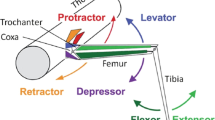Abstract
Stick insects walking with five legs on a self-propelled treadwheel and with the left hindleg (L3) on a motor-driven belt may move the “belt” leg L3 and the “wheel” legs with different frequencies. When L3 made less steps than L2, that step of L2, which was performed during the swing phase of L3, is prolonged. The time interval between the end of swing phase of L3 and the onset of the following swing phase of L2 was remarkably constant. When L3 made more steps than L2, that step of L3, which was performed during the swing phase of L2, is prolonged. Again, the time interval between the end of swing phase of L3 preceding a L2 swing phase and the onset of the L2 swing phase was relatively constant. For both kinds of walking situations phase response curves were drawn. They show that two types of coordinating channels exist: An anteriorly directed type is more dependent on absolute time than on phase. A posteriorly directed type is phase-dependent. Both inhibit the transition from stance to swing for some time. The results are compared with the existing coordination models.
Similar content being viewed by others
References
Bässler, U.: Zur Beeinflussung der Bewegungsweise eines Beines von Carausius morosus durch Amputation anderer Beine. Kybernetik 10, 110–114 (1972)
Chasserat, C., Clarac, F.: Interlimb coordination factors during driven walking in crustacea. J. Comp. Physiol. 39, 293–306 (1980)
Chasserat, C., Clarac, F.: Quantitativ analysis of walking in a decapod crustacean, the rock lobster Jasus lalandii. II. Spatial and temporal regulation of stepping in driven walking. J. Exp. Biol. 107, 219–243 (1983)
Cruse, H.: A new model describing the coordination patterns of the legs of a walking stick insect. Biol. Cybern. 32, 107–113 (1979)
Cruse, H.: A quantitative model of the walking incorporating central and peripheral influences. I. The control of the individual leg. II. The connections between the different legs. Biol. Cybern. 37, 131–144 (1980)
Cruse, H., Epstein, S.: Peripheral influences on the movements of the legs in a walking insect Carausius morosus. J. Exp. Biol. 101, 161–170 (1982)
Cruse, H., Saxler, G.: The coordination of force oscillations and of leg movement in a walking insect (Carausius morosus). Biol. Cybern. 36, 165–171 (1980)
Dean, J., Wendler, G.: Stick insect walking on a wheel: Perturbations induced by obstruction of leg protraction. J. Comp. Physiol. 148, 195–207 (1982)
Epstein, S., Graham, D.: Behaviour and motor output for an insect walking on a slippery surface. I. Forward walking. J. Exp. Biol. 105, 215–229 (1983)
Foth, E., Bässler, U.: Leg movements of stick insects walking with five legs on a treadwheel and with one leg on a motor-driven belt. I. General results and 1:1-coordination. Biol. Cybern. 51, 313–318 (1985)
Foth, E., Graham, D.: Influence of loading parallel to the body axis on the walking coordination of an insect. I. Ipsilateral effects. Biol. Cybern. 47, 17–23 (1983a)
Foth, E., Graham, D.: Influence of loading parallel to the body axis on the walking coordination of an insect. II. Contralateral effects. Biol. Cybern. 48, 149–157 (1983b)
Graham, D.: An analysis of walking in the first instar and adult stick insect Carausius morosus. J. Comp. Physiol. 81, 23–52 (1972)
Graham, D.: Simulation of a model for the coordination of leg movement in free walking insects. Biol. Cybern. 26, 187–198 (1977)
Graham, D.: Unusual step patterns in the free walking grasshopper Neoconocephalus robustus. II. A critical test of the leg interactions underlying different models of hexapod coordination. J. Exp. Biol. 73, 159–172 (1978)
Holst, E. von: Über den “Magnet Effekt” als koordinierendes Prinzip im Rückenmark. Pflügers Arch. Gesamte Physiol. 241, 655–682 (1936)
Holst, E. von: Die relative Koordination als Phänomen und als Methode zentralnervöser Funktionsanalyse. Ergebn. Physiol. 42, 288–306 (1939)
Pavlidis, T.: Biological oscillators: their mathematical analysis. New York: Academic Press, 1973
Stein, P.S.G.: Mechanisms of interlimb phase control. In: Neural control of locomotion. pp. 465–487, Herman, R. et al. eds. New York: Plenum Press, 1976
Wendler, G.: Ein Analogmodell der Beinbewegungen eines laufenden Insekts. Marko, H., Färber, G. Hrsg. München, Wien: Kybernetik, 1968
Wilson, D.M.: Insect walking. Ann. Rev. Entomol. 11, 103–122 (1966)
Author information
Authors and Affiliations
Rights and permissions
About this article
Cite this article
Foth, E., Bässler, U. Leg movements of stick insects walking with five legs on a treadwheel and with one leg on a motor-driven belt. Biol. Cybern. 51, 319–324 (1985). https://doi.org/10.1007/BF00336919
Received:
Issue Date:
DOI: https://doi.org/10.1007/BF00336919




